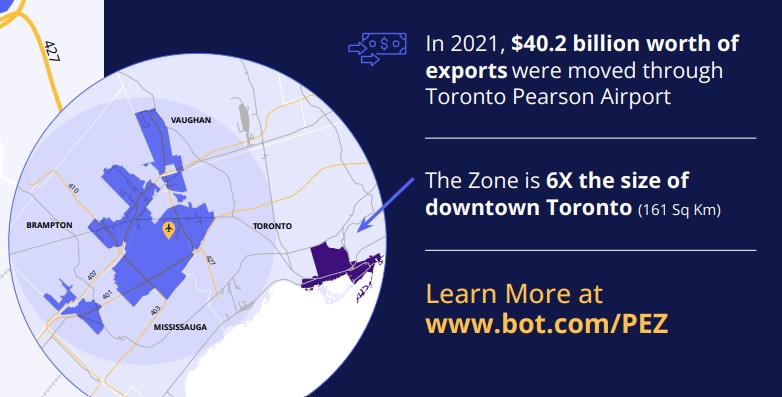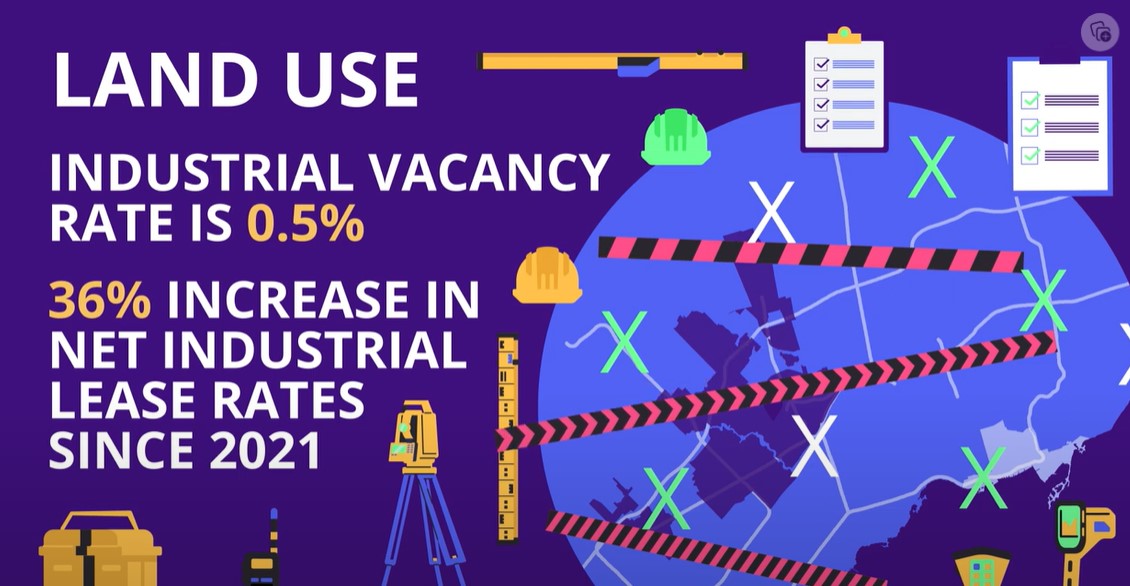By Mark Brooks
Toronto’s Lester B. Pearson airport is the center of an advanced industrial zone that is at the forefront of the reindustrialization of Canada. The PEZ (Pearson Economic Zone) is now Canada’s second largest employment zone, employing 400,000 people and contributing $53 billion to Ontario’s economy. But why, even with land prices soaring, are technically advanced industries such as pharmaceuticals scrambling to be close to an airport? And what happens when available industrial space inside the zone, already know for the lowest vacancy level in north America, is exhausted?
Pearson airport is known to most travelers as Toronto’s only large international passenger airport. It is a gateway to a world of travel opportunities for one third of all Canadians, but it is far more than just a passenger airport. It is a transportation hub at the center of a network of highways, rail links and export orientated advanced manufacturing. The area is home to a significant concentration of firms in pursuit of the business opportunities created by being able to efficiently connect with customers and supply chains around the world. In addition to seventy-seven Fortune 500 companies, the area is home to numerous iconic Canadian success stories, such as MDA, creators of CanadaArm3. One in ten companies in Ontario, from a wide range of industries, are now located within the “PEZ.”
The proximity to an international airport makes it easier for businesses to sell goods and services internationally. The Greater Toronto Airport Authority’s (GTAA’s) Annual Report states that greater than $40.2 Billion dollars’ worth of Air Cargo exports moved through Pearson airport in 2021 to more than 190 countries. That is more than 40% of all Air Cargo in Canada during a year when passenger aviation was next to non-existent due to COVID travel restrictions. In turn, all modern manufacturing relies in part on specialized parts, expertise and services imported through the airport from other nations.

The service industries, warehousing and distribution centers around the airport reflects the interwoven global nature of modern manufacturing supply chains.
According to the International Air Transport Association (IATA) 35% of global commerce by value moves by air. In Ontario, 36% of all warehouse and storage related jobs are located near Pearson airport. The shorter the travel distance to the airport, the shorter the supply chain and the more competitive your business becomes.
The need for a rapid supply chain is even more important when manufacturing goods on demand, when goods are of a highly complex nature, which rely on numerous external dependencies, or your product is perishable. A good example is the fact that 25% of Ontario’s pharmaceutical industry is located within the PEZ.
This global trade finds its way both by dedicated cargo aircraft, as well as in the belly of the hundreds of passenger aircraft, that fly into and out of Pearson International airport from around the world. Pearson airport has sometimes been called an accidental aerotropolis, but there is nothing accidental about its success. It represents decades of arduous work by urban planners, the GTAA and municipal officials including one of Canada’s most iconic mayors, Hazell McCallion (AKA Hurricane Hazell, Mayor of Mississauga for 36 years, from 1978 to 2014).
During her time as Mayor, she helped promote a global vision of free market economics. She picked up where others (including Ontario Premier Bill Davis) left off, helping to promote and open the Toronto region to investors from around the world. She created and led a team in Mississauga that continues to encourage immigration, global investment, and free market economics to this day. During this period, the population of the city of Mississauga increased fourfold from 200,000 to over 800,000 today, mostly from immigration.
The growth of a skilled and ambitious workforce (by immigration) is the other key pillar of Mississauga’s success. Access to a highly educated young energetic workforce within easy commuting distance is a key part of being competitive on a global stage. Immigrants make up 55% of the workers in the PEZ. The language and cultural diversity of the mosaic of people immigrating to the area further enhances global business connections.
McCallion spread the vision by establishing the GTA (Greater Toronto Area) Mayors’ Committee in 1992. She helped to bring together the 30 Mayors, Regional Chairs and other key elected officials to work cooperatively for the economic promotion of the GTA. Her recent death at the age of 101 leaves a legacy of a global economic vision, enabled by an airport, as an example for all Canadians to follow.

Today, problems are looming on the horizon that serves to threaten this vision. The lack local affordable housing compounded by road congestion and a lack of vacant industrial land in the PEZ are threatening to choke off growth. At 0.5%, the Pearson Economic Zone now has the lowest level of vacant industrial land in North America. With no place to build, plus congestion both airside and on roads, long term new investment has no place to go. Trying to pile into the PEZ could curtail GDP growth as well as injure the competitiveness of existing businesses. Soaring housing costs mean new immigrants must live further away creating longer commutes and greater family or social stresses. Lower paying jobs are going unfilled creating staffing issues at the airport itself and in surrounding businesses. Wage costs are soaring.
Ontario’s booming economy could stall unless a solution is found.
New multi-billion dollar investments in road and transit infrastructure can help improve competitiveness but ultimately it is time for a solution decades in the making. It was one supported by Hazel herself when I last heard her speak at a 2019 Toronto Board of Trade event. It is time to move forward with a new aerotropolis in the eastern part of the GTA. A second airport and advanced industrial zone within easy reach of affordable housing, new industrial land, a new logistics hub with a high frequency rail link and the uncongested highway 407.
The land for an airport and associated industry, acquired in the 1970s for just this moment, stands zoned and ready. Ready for a new industrial airport in North Pickering and 30 million square feet of industrial space on 1,400 net hectares of employment land. If properly planned, both the airport and surrounding businesses can be built using private investment with new net zero emissions technology and running on sustainable aviation fuel. An opportunity to incubate new green technology industries.
Pickering Airport can showcase Canadian industry to the world, create 50,000 new jobs and pick up where Hazel and the former Mayor of Pickering, Dave Ryan, left off. To make it happen the PEZ municipalities, all levels of government, industry and local leaders from Durham Region must step up to support the vision.
The torch has been passed to municipal leaders including Kevin Ashe, the newly elected Mayor of Pickering and the Durham region chair John Henry. Working together with leaders from the PEZ, as well as Federal and Provincial leaders, Ontario can attract new investments to create a new green economy. The time for Pickering Airport and its Advanced Enterprise Zone (AEZ) has arrived on the wings of free enterprise, a talented workforce, the global economy, and most of all elected leaders with a vision.
References
Airport Lands – City of Pickering
Pickering Airport in Durham Region’s Development Plan – COPA (copanational.org)
IATA – What Types of Cargo are Transported by Air?
The Pearson Economic Zone Growth Initiative | Toronto Region Board of Trade (bot.com)